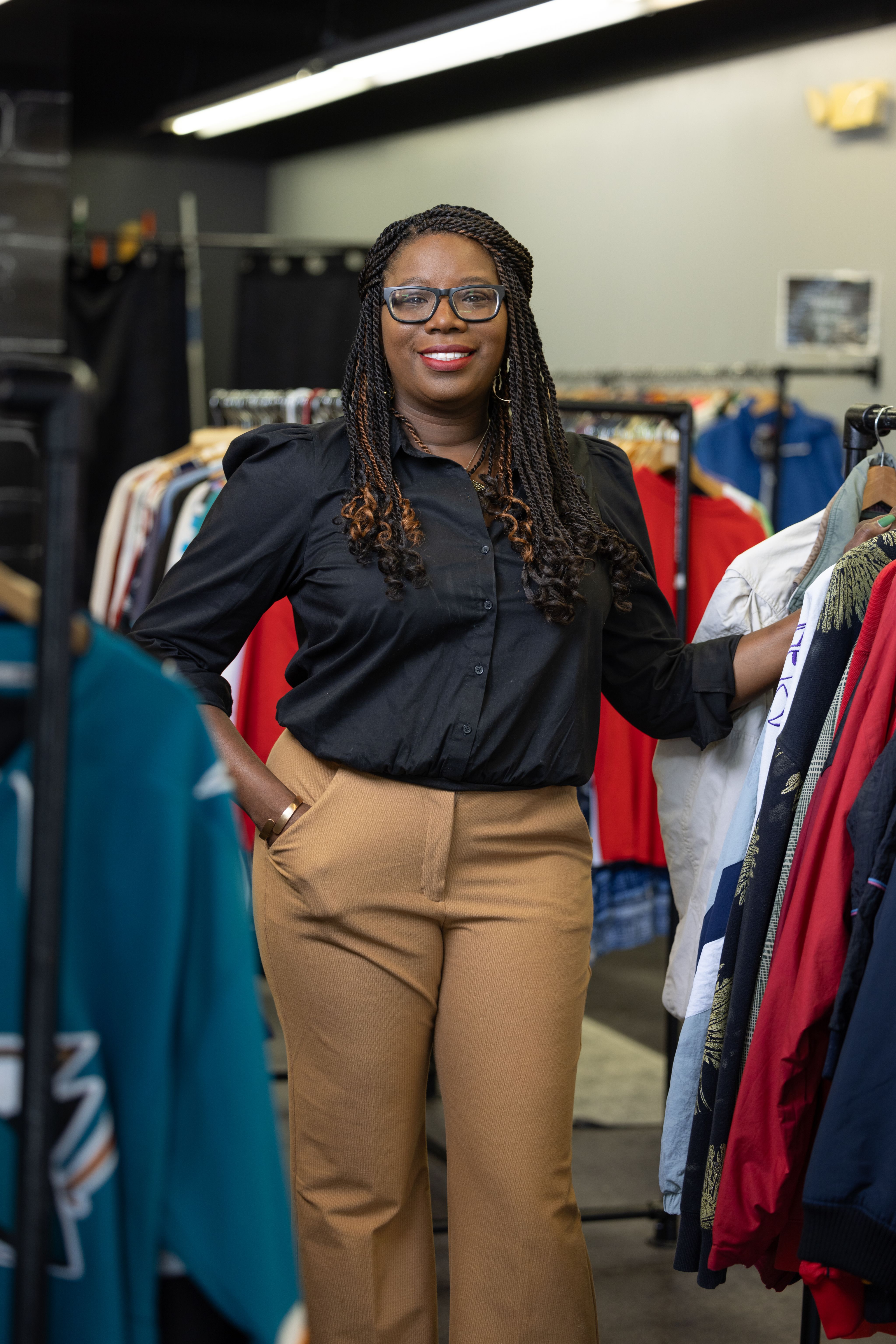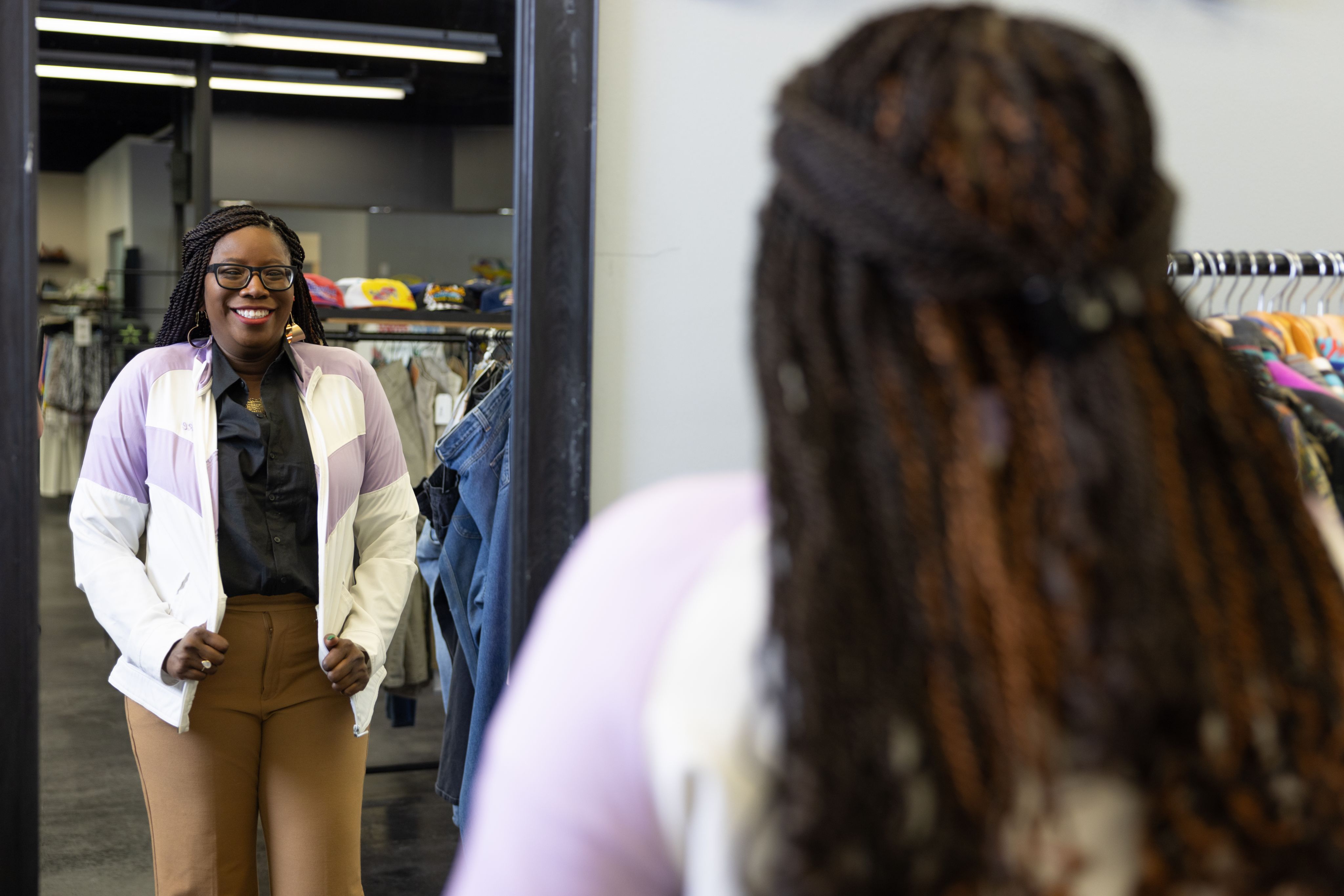Shopping to Save the World
Rather than scold people about their clothes-buying habits, UH Assistant Professor Olivia Johnson focuses on understanding buyer behavior and encouraging a circular retail culture of buying and selling garments secondhand.

Olivia Johnson can’t help but bring her research into the classroom. After all, the University of Houston assistant professor of retailing and consumer science studies the economy of garments, and she often invites her students to discuss how the choices they make getting dressed each morning can affect the planet.
Along with food and housing, clothing is a universal human touchpoint, making it one of the major ways students’ decisions impact the wider economy. When Johnson teaches classes in the Cullen College of Engineering Technology Division, she likes to ask how many of her students believe in the importance of sustainability and social responsibility.
Who can say no to that, right? Nearly all raise their hands. Later she’ll follow up with another question: How many of them are ready to change their buying and consumption habits to make the economy more sustainable? The responses become less committed.
“They’re like, ‘No, but we will send them a really mean tweet. We’ll say something bad on Facebook,’” Johnson says. “I recognized there’s a disconnect. Everybody wants to be sustainable, and that’s a great thing to say. But the question is, are consumers really willing to do that?”
Johnson wants consumers not to think of the planet in the abstract, but to consider the environmental and economic effects their garment purchases have on their own lives.
Rather than scolding people about their buying habits or trusting that consumers will make purchases with the planet in mind, Johnson has focused her research on understanding people’s true buying behaviors in hopes she can prompt them to make a change. She wants consumers not to think of the planet in the abstract, but to consider the environmental and economic effects their garment purchases have on their own lives.
“How do we have the sustainability conversation in different cultural groups and different age groups at different socioeconomic levels?” Johnson asks. “We have to have a conversation with everyone, because if we don’t, we're not going to make an impact.”
Johnson argues appealing to consumers’ self-interest may encourage them to make more sustainable clothing choices, like re-selling old clothes and buying secondhand. Here she shops at New Era Thrifted, a vintage store owned by University of Houston alum Mohamad Kandiel and located on the UH campus.
Johnson argues appealing to consumers’ self-interest may encourage them to make more sustainable clothing choices, like re-selling old clothes and buying secondhand. Here she shops at New Era Thrifted, a vintage store owned by University of Houston alum Mohamad Kandiel and located on the UH campus.
Making Purchases Personal
When Johnson speaks with groups in greater Houston, as she has done since she joined the UH faculty in 2019, she encourages them to think sustainably not by preaching virtue or doom and gloom. Rather, she connects the negative impacts of climate change — which fall disproportionately on people with fewer resources — to the clothes people buy.
She argues that purchasing secondhand clothes (to spare the resources needed to make new ones) or selling clothes rather than throwing them out (to keep them out of landfills) are both ultimately self-interested decisions for people who will bear the brunt of environmental problems.
“She is one of the most energetic, dynamic people I’ve known, and she’s really dedicated to higher education, especially when it comes to helping underserved populations,” says Daeun Chloe Shin, an assistant professor in the Department of Human Development and Consumer Sciences who counts Johnson as a collaborator and mentor. “It may sound a little idealistic, but she wants to offer you the autonomy and the agency of being part of addressing this problem yourself. She wants to empower underserved populations to be active participants.”
The big idea Johnson tries to impart is moving people’s clothes-buying habits into what’s called a circular economy. In short, she wants them to consider the afterlife of garments: what happens to them when we finish with them, whether that’s reusing, reselling or trashing them.
The goal, of course, is to keep them in use for as long as possible. Replacing good clothes is a waste, and throwing out clothes and other textiles is a massive source of landfill garbage.
A circular economy contrasts with a linear economy: buying a garment, using it a few times, then stuffing it into the trash. As crass as that sounds, it’s what happens to most of the clothes Americans buy. Per the Environmental Protection Agency, 11.3 million tons of textile garbage went into U.S. landfills in 2018, plus another 3.2 million tons were burned. Meanwhile, just 2.5 million tons are recycled.
In total, Americans discarded almost triple in 2018 what they threw out in 1990. Americans used to buy less and hold on to clothes longer. Now they buy more and turn clothes into garbage faster, partly driven by cheap and effective overseas suppliers, and partly driven by pressure to look consistently fresh on social media.
Those trends have a heavy impact on the natural environment. Every part of a garment’s life — growing and processing raw materials, making the fabric, sewing and shipping, washing and trashing the item — uses water and fuel and leaves a trail of waste. Synthetic fabrics and blends such as polyester, nylon, acrylic and Lycra all are made partly from fossil fuels, which bring their own social and environmental baggage.
When you consider garments through this broad lens, they begin to look like a huge environmental liability. Between 2000 and 2018, textile waste grew by more than 50%. In that time, average global surface temperature also has been steadily on the rise.
“Unfortunately,” Johnson says, “we're starting to see the effects of our bad behavior.”
“Some scholars study this topic, but she’s the one to really try things out for herself,” says assistant professor Daeun Chloe Shin. “She’s deeply embedded in commerce as a consumer herself.”
“Some scholars study this topic, but she’s the one to really try things out for herself,” says assistant professor Daeun Chloe Shin. “She’s deeply embedded in commerce as a consumer herself.”
Shop Circular, Shop Sustainable
Of course, none of us can lower the world’s temperatures on our own, and most people aren’t too excited about paying more for clothes, even if they’re longer-lasting or more sustainably made. What might encourage them to make different spending choices, Johnson believes, is a more straightforward economic argument.
Even before the phrase “circular economy” came into use, she says, people went to thrift stores, sold their old clothes to vintage shops and participated in secondary clothing markets. That economy has only evolved in recent years to include not just general resellers such as eBay and Facebook Marketplace, but also a roster of clothing- and shoe-specific resellers such as Poshmark.
Together, those outlets can make it profitable for regular people to consider the longer life of their garments. That argument, Johnson says, is more likely to drive sustainable buying decisions than some lecture about climate change.
“Now it’s financially beneficial for people to be sustainable,” Johnson says. “Instead of you just telling me that life is going to be terrible, it’s going to be too hot, you can say, ‘Hey, you spent $60 on this shirt. What if you could get $30 back?’ That gives you an incentive to be sustainable. If we can just encourage the behavior, we’ll get to the outcomes.”
Retailers and resellers have their part to play in this equation, Johnson says. Namely, they need to promote the potential to resell clothes up front when they’re selling new garments.
“The last time we looked at just U.S. retailers, we saw 50 that had a secondhand option for purchasing goods,” Johnson says. “Now, of course, the retailers are interested in how they make more money. But it also brings about a benefit to the customers. In some instances, customers can sell their own products, they’re able to do swaps, they’re able to figure out how to mend their products.”
The work of going retailer by retailer to count and study the programs they’re offering to buy back or resell clothing is painstaking stuff. But it’s also where Johnson applies a genuine interest. She spends hours hunting for her own bold outfits — time that helps her trace the ways that millions of Americans actually interface with the economy.
“Dr. Johnson’s strength is that she really lives in it,” Shin says. “Some scholars study this topic, but she’s the one to really try things out for herself. That’s also where she gets a lot of inspiration, and that’s where she can identify the gap in the research. She’s deeply embedded in commerce as a consumer herself. That’s where a lot of the spark and research ideas come from.”
Retailers promoting their own repairs and resales aren’t the only positive signs Johnson has found in the sector. For one, not all social media encourages blithe consumption. Subcultures of TikTok creators focus on the “treasure hunt” aspect of visiting thrift and vintage stores and the possibility of finding name-brand items on ridiculous markdowns. Showing off a find or an entire look becomes part of the fun — and thus the incentive — to dive into secondhand stores.
“There is this whole idea of gamification,” Johnson says. “This is why people love T.J.Maxx, Marshalls, these kinds of stores. It’s all about the hunt.”
Another positive trend Johnson sees as the culture of work changes, and as young people develop their signature side hustle in the gig economy, is that the notion of renting or reselling clothes is becoming ever more familiar. She hopes that reselling and thrifting in particular shed whatever stigma they may still have, because those are accessible even to people who don’t have much money.
She also notes a growing sense of responsibility to pay garment workers a fair, living wage. On paper, consumers’ awareness of poor labor conditions and subpar pay sounds like a positive development. Consumers who hold manufacturers to high standards, and who are willing to pay a premium to ensure their clothes are made ethically, will logically value those garments more highly and might be inclined to create less waste.
The more promising path to sustainable change, Johnson says, may be for retailers to run their own successful secondary markets.
But Johnson points out that even Americans who say they want to see workers paid better are reluctant to pay more for clothes themselves. The more promising path to sustainable change, she says, may be for retailers to run their own successful secondary markets. A clothing manufacturer that can earn returns on multiple sales of the same item — a jean jacket, a pair of yoga pants, a parka, a pair of aviator sunglasses — will be more inclined to remind consumers to sell an item back to them once they’re through with it, to be resold to another consumer.
“We're not shaming folks,” Johnson says. “We’re saying, you can take and have the same garment or the same look, and you can use these preowned clothes, and it is fun. You get a chance to really think about it and do some treasure hunting. And guess what? You make a difference in the circular economy and what’s happening with our environment.”




